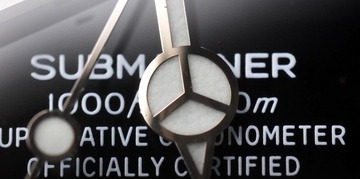Nope, it’s not a nod to the car company. Even though it looks like the Mercedes-Benz logo, this quirky little symbol on Rolex’s hour hand has nothing to do with luxury automobiles.
Take a close look at a Rolex sports watch, You may notice something curious about the hour hand: a circular tip split into three segments, resembling the iconic Mercedes-Benz logo. This distinctive feature, known as the Mercedes hand, has become a hallmark of Rolex’s tool watch lineup. But what exactly is it? Why does Rolex use it? And does it actually have anything to do with the famous German automaker?
What Are Mercedes Hands in Rolex Watches?
The Rolex Mercedes hands are a distinctive style of hour hand found on many Rolex sports watches, most notably the Submariner, GMT-Master, and Explorer models. The hallmark feature of this design is the three-pointed star or “Mercedes” logo shape inside the circular tip of the hour hand.
Design Elements of Mercedes Hands
The design of Rolex Mercedes hands is both functional and distinctive, created specifically for Rolex’s tool and sports watches.
-
Three-Pointed Star (Mercedes Symbol): The most notable feature is the circular tip of the hour hand, which is divided by three spokes radiating from the center, resembling the Mercedes-Benz logo. Despite the resemblance, Rolex has no official affiliation with Mercedes-Benz.
-
Segmented Lume Plot: Each of the three segments within the circle is filled with luminous material, allowing the hour hand to glow in low-light or underwater conditions. The division helps the lume stay intact even if it cracks or shifts.
-
Visual Contrast: The hour hand is thicker and more geometric than the longer, thinner minute hand, making it easy to distinguish at a glance.
-
Stylized Functionality: The star pattern isn’t purely decorative. It adds surface area for luminous paint and balances the visual weight of the hand, so it’s readable without being overpowering.
Supporting Design Features (Often Paired With)
-
Lollipop second hands or arrow-tipped GMT hands
-
Broad minute hands for optimal readability
-
Highly legible dials with luminous hour markers
Let's clear out a few common misconceptions about Rolex Mercedes hands. Despite looking like the Mercedes-Benz emblem, there is no official connection.
Some speculate the three points symbolize land, sea, and air—a nod to Rolex’s all-terrain capability—but this remains unofficial.
History of the Mercedes Hand in Rolex

-
Early 1950s: Rolex begins developing purpose-built tool watches for professional use (e.g., diving, mountaineering, aviation).
-
1953 – Introduction of the Mercedes Hand
-
First seen on the Rolex Submariner and Rolex Explorer.
-
Designed to improve readability and lume stability in extreme environments.
-
1955 – GMT-Master released
-
The Mercedes hour hand appears on the first GMT-Master, reinforcing its role in professional sports watches.
-
1960s to 1980s – Standard for Professional Rolex Models:
-
Becomes a consistent feature on Submariner, Sea-Dweller, Explorer II, and GMT-Master II.
-
Viewed as a functional hallmark of Rolex sports watches.
-
Present Day
-
The Mercedes hand remains a signature design of Rolex’s tool watches.
-
It represents a blend of form, function, and heritage. It's instantly recognizable and still serving its original purpose.
Popular Rolex Watches With Mercedes Hands

1. Rolex Submariner
-
Introduced: 1953
-
Purpose: Professional dive watch
-
Why it’s iconic: The Submariner helped debut the Mercedes hand design. Its clean, functional look and underwater reliability have made it one of Rolex’s most recognizable watches.
2. Rolex GMT-Master and GMT-Master II
-
Introduced: 1955 (GMT-Master), 1983 (GMT-Master II)
-
Purpose: Pilot’s watch with dual time zone functionality
-
Mercedes hand role: Used to differentiate the 12-hour hour hand from the additional 24-hour GMT hand
3. Rolex Explorer
-
Introduced: 1953
-
Purpose: Mountaineering and exploration
-
Notes: Early Explorers featured Mercedes hands for clear legibility during extreme conditions like the Everest expeditions.
4. Rolex Sea-Dweller
-
Introduced: 1967
-
Purpose: Deep-sea diving (deeper rated than the Submariner)
-
Design: Shares many traits with the Submariner, including the use of Mercedes hands for underwater readability.
5. Rolex Yacht-Master
-
Introduced: 1992
-
Purpose: Nautical and regatta timing
-
Details: Combines luxury with sport functionality; includes the Mercedes hour hand as part of its professional aesthetic.
Other Mercedes Watches
Explorer II (ref. 1655 and onward)
-
Early models like the 1655 had a unique “Freccione” (big orange arrow) GMT hand, but later generations (e.g., ref. 16570, 216570, 226570) adopted the Mercedes hour hand design.
Air-King (ref. 116900, 2022-present)
-
The modern Air-King (released 2016, updated 2022) surprisingly includes Mercedes-style hands, unlike older Air-Kings, which had simple baton hands.
-
Shares design cues with the Explorer due to its professional instrument aesthetic.
Milgauss (some prototypes and rare references)
-
Most Milgauss models feature lightning-bolt seconds hands and baton-style hour/minute hands.
-
However, a few vintage prototype models reportedly featured Mercedes hands, though these are extremely rare and mostly of interest to collectors.
Models That Do Not Use Mercedes Hands
Just to clarify, you won’t find Mercedes hands on the following Rolex lines:
-
Datejust
-
Day-Date
-
Oyster Perpetual
-
Cellini
-
Sky-Dweller
-
Most vintage dress watches
These models favor stick, baton, leaf, or Roman-style hands, which align better with their elegant design language.
Conclusion
The Mercedes hand is a thoughtful solution born out of Rolex’s dedication to function and reliability. While it might look like the logo of a luxury car brand, its true purpose is to improve legibility and durability in demanding environments. From deep dives to high-altitude adventures, the Mercedes hand has stood the test of time as an unmistakable symbol of Rolex’s heritage and commitment to top quality.





